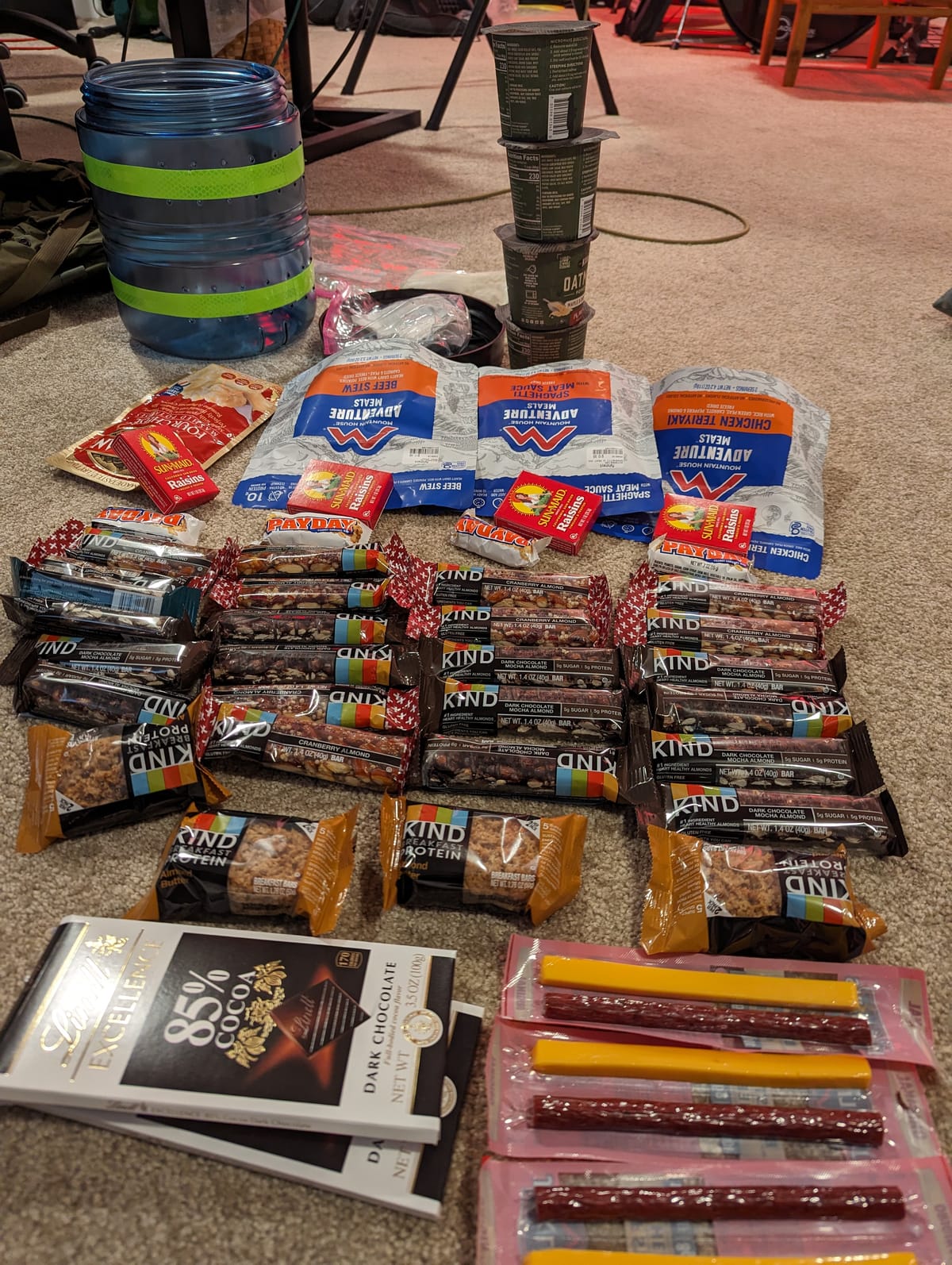On Food

While in a holding pattern, I've taken some time to refine my starting food load. This initial supply will only last me about four days out of many, and it's very unlikely I'll be able to replace it exactly, but it still serves as a model for my ideal food supply.
The goals of carrying food on a multi-day leg:
- Consume enough calories to offset the activity. The golden 2,000 calories/day recommendation doesn't cut it for hiking or labor.
- Consume enough sodium and other electrolytes to offset sweat and water intake. Too much sodium is an easier problem to solve than too little.
- Carry as little food weight as possible to make it to the next resupply. More than about eight pounds of food can be enough weight to cause problems for me and my light frame.
- Consume enough nutrients to not cause problems. It would be kind of embarrassing to suffer scurvy while going for a walk. The more common problem is stress fractures or shin splints resulting from insufficient calcium.
I leaned heavily on GearSkeptic's series on performance nutrition for backpacking for a compilation of research and advice on planning the ideal diet for such an activity.
Optimizing food carry weight is pretty straightforward. Calories from fat are lighter, a difference of 9 calories per gram from fat to 4 calories per gram from carbs or protein. From there, we seek the limit of how much fat intake we can realistically operate with.
During activity at a moderate level of about 45% VO2 max, research suggests that around 70% of my energy can come from aerobic fat burning. The remaining 30% can come from anaerobic burning of carbs and protein, converted to glycogen. A 3:1 to 4:1 ratio of carbs to protein should be effective at keeping the fires burning. Of those carbs consumed during activity, most should be complex carbohydrates as opposed to sugars, for longer term supply.
A few foods hit these ratios nearly perfectly. Most flavors of KIND bar with dark chocolate are nearly on the nose. 85% dark chocolate bars are also a very efficient way to pack the ideal ratio. Somewhere in Virginia, Matt will be wondering why all of his food melted..
While a diet of KIND and dark chocolate bars doesn't sound so bad, and they should be pretty easy to find along the way, they don't provide near enough sodium or other nutrients to be the sole source of energy. A higher protein meal at the end of the day should aid in muscle regeneration and bestow a little thermic effect to help stay warm at night. This can be in the form of anything from gas station beef snacks to freeze-dried Mountain House meals, which are my ideal pick.
On top of real food, I'll also be carrying tea bags for preparing herbal tea in the morning. This should be a good ritual for starting the day with consistent hydration.
I will be carrying an isobutane stove and a 750mL pot for food preparation. For my initial food load, I have a couple of extra convenience requirements:
- I can eat everything without touching it. I expect my hands will be dirty most of the time, so this is an extra layer of protection from all sorts of food poisoning problems.
- I don't have to wash dishes, except my spoon. The Mountain House meals can be cooked in the bag, and I don't have to wash after making my morning tea.
To help keep up my nutrients and electrolytes, I've prepared little baggies of Centrum multi-vitamins and Trace electrolyte supplements. I'll also be bringing a daily supply of string cheese to help keep my calcium up. Stress fractures are a rarely talked about but statistically likely way to pause or end a thru-hike.
Despite all my research and planning, there are still plenty of unknowns. Every resupply stop will have a different selection and I'll need to solve the puzzles of fat ratios, calorie counting, and physically packing the bear canister each time. I may find that boiling water twice a day uses more fuel than I care to replace.